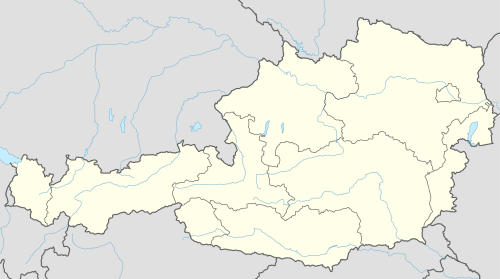Ebensee
| Ebensee | ||
|---|---|---|
 | ||
| ||
 Ebensee Location within Austria | ||
| Coordinates: 47°48′30″N 13°46′30″E / 47.80833°N 13.77500°ECoordinates: 47°48′30″N 13°46′30″E / 47.80833°N 13.77500°E | ||
| Country | Austria | |
| State | Upper Austria | |
| District | Gmunden | |
| Government | ||
| • Mayor | Markus Siller (SPÖ) | |
| Area | ||
| • Total | 194.5 km2 (75.1 sq mi) | |
| Elevation | 443 m (1,453 ft) | |
| Population (1 January 2016)[1] | ||
| • Total | 7,739 | |
| • Density | 40/km2 (100/sq mi) | |
| Time zone | CET (UTC+1) | |
| • Summer (DST) | CEST (UTC+2) | |
| Postal code | 4802 | |
| Area code | 06133 | |
| Vehicle registration | GM | |
| Website | www.ebensee.at | |
Ebensee is a market town in the Traunviertel region of the Austrian state of Upper Austria, located within the Salzkammergut Mountains at the southern end of the Traunsee. The regional capital Linz lies approximately 90 km (56 mi) to the north, nearest towns are Gmunden and Bad Ischl. The municipality also comprises the Katastralgemeinden of Langwies, Oberlangbath, Rindbach, Kohlstatt and Roith.
History
With the Traunviertel, Ebensee since 1180 belonged to the Duchy of Styria held by the House of Babenberg from 1192, until in 1254 King Ottokar II of Bohemia finally allocated it to his Austrian duchy. Ebensee itself was first mentioned in a 1447 deed.
From 1596 on Emperor Rudolph II of Habsburg had a salt evaporation pond erected near the settlement, supplied with brine being delivered via a 40 km (25 mi) long pipeline from the salt mines around Hallstatt. Ebensee therefore was the primary production centre for salt in Austria. Historically, the site was chosen because of the rich forests, whose wood was used to boil the salt out of the brine. In 1883 the Belgian chemist Ernest Solvay established soda works of the Solvay company at Ebensee. Although a former industrial center in the larger Salzkammergut region, it has recently fallen on bad fortunes with the closure of some of the larger factories.
Nazi Concentration Camp
In 1943, the SS established Ebensee concentration camp (codename "Zement") near the town, a planned emergency location for the Peenemünde research centre after the RAF Operation Hydra attack. It was part of the Mauthausen network. Slave laborers were worked to death digging tunnels for armaments storage. The camp was liberated by American soldiers in May 1945. Due to the extremely high death rates, Ebensee is considered one of the most horrific Nazi concentration camps.
Used as a Displaced Persons camp after the war, the area is today site of a memorial and a museum.
Population
| Historical population | ||
|---|---|---|
| Year | Pop. | ±% |
| 1991 | 8,800 | — |
| 2001 | 8,451 | −4.0% |
| 2011 | 7,871 | −6.9% |
Politics
Seats in the municipal assembly (Gemeinderat) as of 2009 elections:
- Social Democratic Party of Austria (SPÖ): 18
- Austrian People's Party (ÖVP): 9
- Citizens' List for Ebensee (Independent): 8
- Freedom Party of Austria (FPÖ): 2
Tourism
Ebensee is surrounded by three picturesque lakes, the Traunsee, the Offensee and the Langbathsee. The Traunsee is large enough to be used for boating, while the other two lakes are smaller, surrounded by mountains, and used only for bathing; both are protected natural areas. On the shore of the Langbathsee is a 19th-century hunting lodge erected at the behest of Emperor Franz Joseph I of Austria.

Since 1927 an aerial tramway built by the Bleichert engineering company runs up to the summit of the Feuerkogel mountain. Other tourist attractions include the Gasselhöhle show cave and a small skiing area with about ten lifts.
Parts of the 1968 Where Eagles Dare film were shot in the Ebensee area.
International relations
Twin towns — Sister cities
Ebensee is twinned with:
Notable people
- Frederick Katzer (1844–1903), Bishop of Green Bay
References
External links
| Wikivoyage has a travel guide for Ebensee. |
![]() Media related to Ebensee at Wikimedia Commons
Media related to Ebensee at Wikimedia Commons
